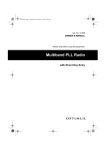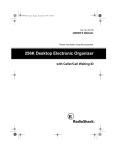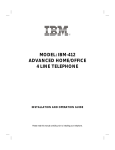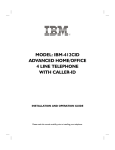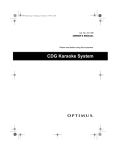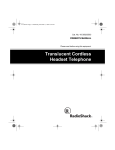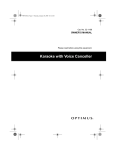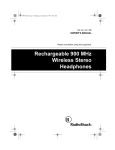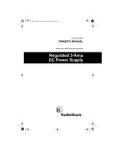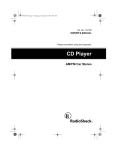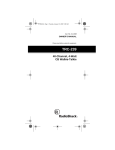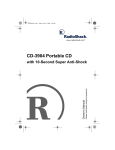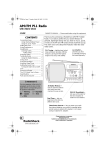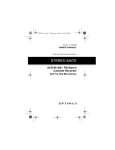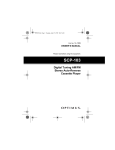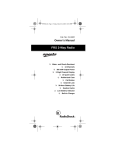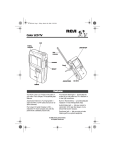Download Optimus CD-3840 Portable CD Player User Manual
Transcript
42-5098.fm Page 1 Wednesday, January 19, 2000 4:03 PM Cat. No. 42-5098 OWNER’S MANUAL Please read before using this equipment. CD-3840 Portable CD Player with 40 Second Super Anti-Shock and PLL AM/FM Tuner 42-5098.fm Page 2 Wednesday, January 19, 2000 4:03 PM FEATURES Your Optimus Portable CD Player uses the latest digital audio technology to give you the clean, crisp sound of compact discs. You can connect the CD player to amplified speakers or your home or car audio system, or connect a pair of stereo headphones for portable, private listening. Important: You need a pair of stereo headphones, amplified speakers, or a home audio or car stereo system to use your CD player. Your local RadioShack store carries a complete line of these items. The CD player's features include: Super Anti-Shock System (SAS) — rapidly scans 40 seconds of data from the CD and stores it in memory for uninterrupted play with no sound skip even when the CD player is exposed to shocks or vibration. This makes this CD player excellent for use in your vehicle. AM/FM Radio with 20-Station Memory — lets you store up to 20 radio stations (15 FM and 5 AM) in memory, so you can quickly tune to a stored station. Backlit Display — lets you see the system’s status, even in the dark. E-Bass System — creates a fuller bass sound. Programmable Play — lets you program and play up to 22 tracks in any sequence you choose. Repeat Play — lets you automatically repeat a single track, a programmed sequence, or an entire CD. Intro Scan — helps you locate a desired track by automatically playing the first 10 seconds of each track on the CD. Random Play — lets you play the tracks on a CD in random order. Eight-Times Oversampling with Digital Filtering — improves the CD’s sound by multiplying the standard 44.1 kHz sample rate by 8 and using a digital filter to reduce or eliminate distortion. 1-Bit DAC — uses the latest in digitalto-analog conversion circuitry to accurately reproduce all sound levels with virtually no distortion. Built-In Battery Charger — automatically charges rechargeable batteries inside the player when you connect an AC or DC adapter. Automatic Search Music System (ASMS) — lets you quickly locate and play any track on a CD. © 1999 Tandy Corporation. All Rights Reserved. Optimus, RadioShack, and Adaptaplug are registered trademarks used by Tandy Corporation. 2 42-5098.fm Page 3 Wednesday, January 19, 2000 4:03 PM Audible Search and Skip Function — helps you locate a particular section of a track by rapidly playing the CD in either direction. CDs that can be played on this CD player have this mark on them: Pause — lets you temporarily stop play. Hold — helps prevent accidentally changing the CD player's settings and preserves battery life by locking most controls when you turn off the CD player. The CD player’s advanced technology makes it simple to operate. But, be sure you read this Owner’s Manual completely so you can take advantage of all its advanced features. Auto Power Off — automatically turns the CD player off when you stop play or 30 seconds after the CD finishes playing. This CD player is made and tested to meet exacting safety standards. It meets FCC requirements and complies with safety performance standards of the U.S. Department of Health and Human Services. Three Power Sources — let you power your CD player from two AA batteries (not supplied), standard AC power, or vehicle battery power (using an optional AC or DC adapter). Warnings: 3-Inch CD Compatible — lets you play 3-inch CDs. • This CD player employs a laser light beam. Only a qualified service person should remove the cover or attempt to service this device, due to possible eye injury. Automatic Tuning — searches forward or backward to the next strong station in the selected band so you can quickly find new stations. • The use of controls, adjustments, or procedures other than those specified herein might result in hazardous radiation exposure. Memory Tuning — lets you select a preset AM or FM station. Stereo/Mono Switch — lets you select mono or stereo mode when listening in the FM band. 3 42-5098.fm Page 4 Wednesday, January 19, 2000 4:03 PM FCC INFORMATION This equipment complies with the limits for a Class B digital device as specified in Part 15 of FCC Rules. These limits provide reasonable protection against radio and TV interference in a residential area. However, your CD player might cause TV or radio interference even when it is operating properly. To eliminate interference, you can try one or more of the following corrective measures: • Increase the distance between the CD player and the radio or TV. • Use outlets on different electrical circuits for the CD player and the radio or TV. Consult your local RadioShack store if the problem still exists. 4 42-5098.fm Page 5 Wednesday, January 19, 2000 4:03 PM CONTENTS Powering the CD PLayer ...................................................................................... Using Batteries ................................................................................................. Charging Rechargeable Batteries ............................................................. Using AC Power ............................................................................................... Using Vehicle Battery Power ............................................................................ 6 6 6 7 8 Making the Connections ...................................................................................... Connecting Earphones or Headphones ........................................................... Listening Safely ......................................................................................... Traffic Safety .............................................................................................. 9 9 9 9 Operation ............................................................................................................. 10 Listening to the Radio .................................................................................... 10 Storing a Radio Station in Memory ........................................................... 11 Playing a CD ................................................................................................... 11 Super Anti-Shock System (SAS) ............................................................. 12 Skip and Audible Search ......................................................................... 12 Intro Scan ................................................................................................ 13 Repeat Play ............................................................................................. 13 Random Play ........................................................................................... 13 Programmed Play .................................................................................... 14 Troubleshooting ................................................................................................. 15 Care and Maintenance ....................................................................................... 17 CD Care Tips ................................................................................................. 18 Specifications ..................................................................................................... 19 5 42-5098.fm Page 6 Wednesday, January 19, 2000 4:03 PM POWERING THE CD PLAYER You can power your CD player from any of these sources: • two AA alkaline batteries (not supplied) • two rechargeable AA nickel-cadmium batteries (not supplied) • standard AC power using an AC adapter (not supplied) 1. Press down and slide the battery compartment cover in the direction of the arrow and lift it off. 2. Place two AA batteries in the compartment as indicated by the polarity symbols (+ and –) marked inside. 3. Replace the cover. When flashes or the CD player stops operating properly, replace the batteries. B ATT • vehicle battery power using a DC adapter (not supplied) Note: Connecting an AC or DC adapter to the CD player with non-rechargeable batteries installed disconnects the batteries. USING BATTERIES You can power your CD player from two AA alkaline batteries or two AA rechargeable nickel-cadmium batteries. Both types of batteries are available at your local RadioShack store. Cautions: • Use only fresh batteries of the required size and recommended type. • Do not mix old and new batteries, different types of batteries (standard, alkaline, or rechargeable), or rechargeable batteries of different capacities. Follow these steps to install the batteries. 6 Warning: Dispose of old batteries promptly and properly. Do not burn or bury them. Caution: If you do not plan to use the CD player for a month or more, remove the batteries. Batteries can leak chemicals that can destroy electronic parts. Charging Rechargeable Batteries This CD player can fully charge the recommended rechargeable nickel-cadmium batteries in about 17 hours. You can play a CD while charging the nickelcadmium batteries; however, this will cause the batteries to charge more slowly. 42-5098.fm Page 7 Wednesday, January 19, 2000 4:03 PM Follow these steps to charge rechargeable batteries. 1. Connect an optional AC or DC adapter to the CD player’s DC IN 4.5V jack (see “Using AC Power” or “Using Vehicle Battery Power” on Page 8). USING AC POWER You can power the CD player using an 4.5-volt, 600-mA AC adapter and a size ® B Adaptaplug adapter (neither supplied). Both adapters are available at your local RadioShack store. Cautions: You must use a Class 2 adapter that supplies 4.5 volts DC and delivers at least 600 mA. Its center tip must be set to positive and its plug must fit the CD player's DC IN 4.5V jack. Using an adapter that does not meet these specifications could damage the CD player or the adapter. ! 2. After 17 hours, unplug the adapter then disconnect it from the CD player’s DC IN 4.5V jack. Caution: Do not overcharge the batteries. Overcharging can significantly reduce the batteries' useful life. 22 1- Important: This CD player can use nickelcadmium rechargeable batteries. At the end of a 80 0-8 4 3-74 nickel-cadmium battery's useful life, it must be recycled or disposed of properly. Contact your local, county, or state hazardous waste management authorities for information on recycling or disposal programs in your area or call 1-800843-7422. Some options that might be available are: municipal curbside collection, drop-off boxes at retailers such as your local RadioShack store, recycling collection centers, and mail-back programs. • Always connect the AC adapter to the CD player before you connect it to AC power. When you finish, disconnect the adapter from AC power before you disconnect it from the CD player. Follow these steps to connect the CD player to AC power. 1. Insert the recommended Adaptaplug adapter into the AC adapter’s cord, setting TIP to + (positive). 2. Set the AC adapter’s voltage switch to 4.5V. 3. Insert the AC adapter’s barrel plug into the CD player’s DC IN 4.5V jack. 4. Plug the other end of the adapter into a standard AC outlet. 7 42-5098.fm Page 8 Wednesday, January 19, 2000 4:03 PM 5. When you finish using the AC adapter, disconnect it from the AC outlet first, then unplug it from the CD player. Note: Always unplug the AC adapter before using the CD player with alkaline batteries. Otherwise the player will not operate. Follow these steps to connect the CD player to vehicle battery power. 1. Insert the recommended Adaptaplug adapter into the DC adapter’s cord, setting TIP to + (positive). 2. Set the DC adapter’s voltage switch to 4.5V. 3. Insert the DC adapter’s barrel plug into the CD player’s DC IN 4.5V jack. USING VEHICLE BATTERY POWER 4. Plug the other end of the adapter into your vehicle's cigarette-lighter socket. You can power the CD player from a vehicle’s 12V power source (such as cigarette-lighter socket) using a 4.5-volt, 600-mA DC adapter and a size B Adaptaplug adapter (neither supplied). Both adapters are available at your local RadioShack store. 5. When you finish using the DC adapter, disconnect it from the vehicle’s cigarette-lighter socket first, then unplug it from the CD player. Cautions: You must use an adapter that supplies 4.5 volts DC and delivers at least 600 mA. Its center tip must be set to positive and its plug must fit the CD player's DC IN 4.5V jack. Using an adapter that does not meet these specifications could damage the CD player or the adapter. ! • Always connect the DC adapter to the CD player before you connect it to the power source. When you finish, disconnect the adapter from the power source before you disconnect it from the CD player. 8 Note: Always unplug the DC adapter before using the CD player with alkaline batteries. Otherwise the player will not operate. 42-5098.fm Page 9 Wednesday, January 19, 2000 4:03 PM MAKING THE CONNECTIONS You can listen to your CD player by connecting earphones, headphones, or amplified speakers to the player’s PHONES jack, or by connecting a home audio or autosound system to the CD player’s LINE OUT jack. PHONES NES PHO OUT LINE VOL LINE OUT Notes: • If the jacks on your equipment do not match the plugs on the supplied Y-cable, check with your local RadioShack store for the proper cable adapter. • If you use amplified speakers, connect them to the PHONES jack, not LINE OUT. Otherwise, FM radio reception might be weak or noisy. CONNECTING EARPHONES OR HEADPHONES For private listening, you can plug a pair of stereo earphones or headphones 1 (not supplied) with a /8-inch (3.5-mm) plug into the PHONES jack on the CD player. Listening Safely To protect your hearing, follow these guidelines when you use earphones or headphones. • Set the volume to the lowest setting before you begin listening. After you begin listening, adjust the volume to a comfortable level. • Do not listen at extremely high volume levels. Extended high-volume listening can lead to permanent hearing loss. • Once you set the volume, do not increase it. Over time, your ears adapt to the volume level, so a volume level that does not cause discomfort might still damage your hearing. Traffic Safety Do not wear earphones or headphones while operating a motor vehicle or riding a bicycle. This can create a traffic hazard and could be illegal in some areas. Even though some earphones and headphones let you hear some outside sounds when listening at normal volume levels, they still can present a traffic hazard. 9 42-5098.fm Page 10 Wednesday, January 19, 2000 4:03 PM OPERATION LISTENING TO THE RADIO 1. Repeatedly press TUNER ON/BAND until the desired band (AM, FM1, FM2, or FM3) appears. Memory Tuning: Press one of the five memory buttons (P1 through P5) to directly select a preset station. You can set up to 20 presets (see “Storing a Radio Station in Memory” on Page 11). Notes: 2. Rotate VOL to a comfortable listening level. VOL 3. Use one of these methods to tune to the desired station. The display shows the tuned frequency. Manual Tuning: Repeatedly press TUNING + or – to tune up or down the selected band. To tune the band more quickly, hold down TUNING + or –. Automatic Tuning: Hold down TUNING + or – for about two seconds, then quickly release it. The CD player tunes up or down the selected band, stopping at the next station with a strong signal. 10 • The CD player has a built-in AM antenna. For the best AM reception, rotate the CD player. • The supplied Y-cable or an optional earphones’ or headphones’ cord serves as an FM antenna. For the best FM reception, fully uncoil the cord. • When listening to an FM station broadcasting in stereo, press STEREO/MONO. ST appears. If reception is poor or noisy, press STEREO/MONO again. MONO appears. The sound is not in stereo, but reception should improve. 4. Press TUNER OFF to turn off the radio. 42-5098.fm Page 11 Wednesday, January 19, 2000 4:03 PM Storing a Radio Station in Memory You can store up to 20 stations (15 FM and 5 AM) in memory — 5 each in AM, FM1, FM2, and FM3. 1. Turn on the radio and tune the desired band and station. 2. Hold down one of the memory buttons (P1 through P5) until PRESET appears. the CD lies flat in the compartment. Then close the compartment cover. Note: This CD player plays 3-inch single CDs without an adapter. 3. Press PLAY/PAUSE. The CD player turns on, 01 appears, the total number of tracks and playing time appear for about 2 seconds, then Track 1 begins to play. The display shows the current track number and the playing time. 3. Repeat Steps 1 and 2 for each memory button where you want to store a station. Note: To replace a stored station, simply store a new one in its place. 4. Adjust VOL to a comfortable listening level. PLAYING A CD Notes: 1. Slide OPEN in the direction of the arrow to open the disc compartment. • If you connected the CD player's LINE OUT jack to your home audio or autosound system, use the volume controls on those systems. • To enhance the bass sound, slide E-BASS to ON. To return to normal sound, switch E-BASS to OFF. OPEN E-BASS 2. Carefully handle the CD by its edges and place it label side up over the compartment's center hub. Press gently on the CD's center so • To temporarily stop play, press PLAY/PAUSE. The playing time flashes. To resume play, press PLAY/PAUSE again. 11 42-5098.fm Page 12 Wednesday, January 19, 2000 4:03 PM 5. The CD plays to the end, then play stops. You can press STOP/TUNER OFF once to stop play sooner. 6. Be sure the CD has stopped spinning, then slide OPEN in the direction of the arrow to open the disc compartment. Hold the edge of the disc and gently press the center hub, then remove the disc. When the CD player is stopped for about 30 seconds, the power automatically turns off. To turn it off sooner, press STOP/TUNER OFF again. Super Anti-Shock System (SAS) Your CD player contains special circuits to overcome skipping problems caused by shock or vibration. This means you can listen to the CD player anywhere you go or use it in your vehicle. When you turn on the anti-shock system, the CD player continuously saves the next 40 seconds of music in memory. During a shock or vibration that would normally make a track skip or pause, the CD player plays directly from memory. If the player is subjected to shocks of over 40 seconds duration, 12 some interruption of sound output will occur. This is normal. The sound resumes once the shock subsides. To turn on the anti-shock system, press ANTI-SHOCK. If a CD is playing, the sound mutes for about 1 second, then appears. To turn off the anti-shock system, press ANTI-SHOCK again. The sound briefly stops and disappears. Note: While the SAS system provides for continuous sound output when the CD player is subjected to shock or vibration, it will not correct errors arising from the use of defective, scratched or dirty discs. Skip and Audible Search Press SKIP/SEARCH during play to go to the beginning of the next track, SKIP/SEARCH to return to the beginning of the current track, or SKIP/SEARCH twice to return to the beginning of the previous track. 42-5098.fm Page 13 Wednesday, January 19, 2000 4:03 PM SKIP/SEARCH or Hold down during play to rapidly search forward or backward for a specific section of a track. The CD plays at a lower volume and a higher speed. The current track's elapsed time appears. Intro Scan The Intro Scan feature automatically plays the first 10 seconds of each track on a CD. • To start Intro Scan from the first track, while the CD is stopped, repeatedly press PLAY MODE until Intr appears. Then press PLAY/ PAUSE. Repeat Play Your CD player can repeatedly play a single track, a sequence of tracks (see “Programmed Play” on Page 14), or an entire CD. During play, repeatedly press REPEAT/ ENTER. When REPEAT flashes, the current track will be repeated. When REPEAT appears steadily, all tracks on the disc will be repeated. To cancel repeat play, press REPEAT/ ENTER until REPEAT disappears. Random Play In random play, the CD player plays all the tracks in random order once, then automatically stops. To start random play, repeatedly press PLAY MODE until RND appears, then press PLAY/PAUSE. • To start Intro Scan from the beginning of the current track during play, repeatedly press PLAY MODE until Intr appears, then press SKIP/ SEARCH . • To start Intro Scan from the next track during play, repeatedly press PLAY MODE until Intr appears. Then press SKIP/SEARCH . To resume normal play, press PLAY Intr disappears. To start random play from the current track, repeatedly press PLAY MODE until RND flashes. Random play begins after the current track plays. When all tracks on the disc have been played, the player automatically stops. To cancel random play sooner, press PLAY MODE again to return to the normal play mode. RND disappears. MODE so 13 42-5098.fm Page 14 Wednesday, January 19, 2000 4:03 PM Programmed Play You can program up to 22 tracks on a CD to play in any order you choose. Follow these steps to program and play a sequence. 1. Repeatedly press PLAY MODE until PROG flashes. 00 and P-01 appear and PROG flashes again. SKIP/ 2. Repeatedly press SEARCH or to display the number of the first track you want to program. 3. Press REPEAT/ENTER to store the track number and go to the next selection. The selection number advances by one and the track number returns to 00. 4. Repeat Steps 1–3 for each track you want to program, up to 22 tracks. 5. To play the programmed sequence, press PLAY/PAUSE. 6. To cancel programmed play, press PLAY MODE until PROG disappears, or press STOP. To erase the sequence, press STOP twice to turn off the player, or open the CD compartment cover. 14 42-5098.fm Page 15 Wednesday, January 19, 2000 4:03 PM TROUBLESHOOTING With proper care and handling, your CD player should give you years of trouble-free service. However, if your CD player is not working properly, follow these suggestions to see if you can eliminate the problem. If you still have a problem, take the CD player to your local RadioShack store for assistance. Problem CD will not play Possible Cause Solution CD is upside down Reinstall the CD label side up. CD is not seated snugly on compartment’s center hub Gently press down on the CD. Dirty or defective CD Clean or replace the CD. Dirty pickup lens Use a CD lens cleaning kit (available at your local RadioShack store) to clean the lens. Player lid is not closed Press down on the lid. Moisture/Condensation Allow the player to warm up to room temperature for 60 minutes. AC power to adapter switched off Switch on the AC power. Weak batteries Replace the batteries or charge rechargeable batteries. The CD player has automatically turned off Press PLAY to restore power. No sound from headphones The headphones’ plug is not firmly inserted in the PHONES jack, or headphones are connected to the LINE OUT jack Insert the headphones’ plug firmly into the PHONES jack. No sound or intermittent sound when played through an external audio system CD player is subject to excessive vibration or shock Place the CD player on a stable surface. 15 42-5098.fm Page 16 Wednesday, January 19, 2000 4:03 PM Problem Noisy or distorted radio reception Possible Cause Solution Station not tuned properly Retune the station. Antenna needs adjustment Turn the CD player for best AM reception. Adjust the FM antenna (headphone cord). 16 42-5098.fm Page 17 Wednesday, January 19, 2000 4:03 PM CARE AND MAINTENANCE Your Optimus Portable CD Player is an example of superior design and craftsmanship. The following suggestions will help you care for your CD player so you can enjoy it for years. Keep the CD player dry. If it gets wet, wipe it dry immediately. Liquids might contain minerals that can corrode the electronic circuits. Use and store the CD player only in normal temperature environments. Temperature extremes can shorten the life of electronic devices, damage batteries, and distort or melt plastic parts. Keep the CD player away from dust and dirt, which can cause premature wear of parts. Handle the CD player gently and carefully. Dropping it can damage circuit boards and cases and can cause the CD player to work improperly. Use only fresh batteries of the required size and recommended type. Batteries can leak chemicals that damage your CD player’s electronic parts. Wipe the CD player with a damp cloth occasionally to keep it looking new. Do not use harsh chemicals, cleaning solvents, or strong detergents to clean the CD player. Modifying or tampering with the CD player’s internal components can cause a malfunction and might invalidate its warranty and void your FCC authorization to operate it. If your CD player is not performing as it should, take it to your local RadioShack store for assistance. 17 42-5098.fm Page 18 Wednesday, January 19, 2000 4:03 PM CD CARE TIPS • Do not place anything but a CD in the disc compartment. Doing so can damage the drive mechanism. • During playback, a severe shock or jolt could make the CD's rotation speed change suddenly and produce some noise. This is not a malfunction. • Always handle a CD by its edges and keep it in its protective case or sleeve when it is not in use. Fingerprints and scratches on the CD's surface can prevent the laser beam from correctly reading the digital information. To clean the CD, use a CD cleaner kit. • A scratch on the CD's surface can make the CD skip or stop playing. If the CD gets scratched, use RadioShack Scratch ’n Fix to repair the scratch. • Keep CDs dry. A water drop can act as a lens and affect the laser beam focus. 18 42-5098.fm Page 19 Wednesday, January 19, 2000 4:03 PM SPECIFICATIONS Frequency Response (±3 dB) ............................................................. 20–20,000 Hz Line Output ....................................................................................................... 0.6 V Sampling Frequency ................................................................................... 44.1 kHz Oversampling ............................................................................................... 8 Times Wavelength ................................................................................................... 780 nm Power Requirements ................................................................................... DC 4.5V Two AA Alkaline or Rechargeable Nickel-Cadmium Batteries Optional AC or DC Adapter (Not Supplied) Power Consumption ............................................................................................ 8 W Battery Life ................................................................................................... 8 Hours Dimensions (HWD) ............................ 61/5 × 51/10 × 13/10 Inches (153 × 131 × 34 mm) Weight (without batteries) ............................................................... 296 g (10.44 oz) Weight (with batteries) .................................................................... 330 g (11.64 oz) Included Accessory ..................................................................................... Y-Cable Specifications are typical; individual units might vary. Specifications are subject to change and improvement without notice. 19 42-5098.fm Page 20 Wednesday, January 19, 2000 4:03 PM Limited Ninety-Day Warranty This product is warranted by RadioShack against manufacturing defects in material and workmanship under normal use for ninety (90) days from the date of purchase from RadioShack companyowned stores and authorized RadioShack franchisees and dealers. EXCEPT AS PROVIDED HEREIN, RadioShack MAKES NO EXPRESS WARRANTIES AND ANY IMPLIED WARRANTIES, INCLUDING THOSE OF MERCHANTABILITY AND FITNESS FOR A PARTICULAR PURPOSE, ARE LIMITED IN DURATION TO THE DURATION OF THE WRITTEN LIMITED WARRANTIES CONTAINED HEREIN. EXCEPT AS PROVIDED HEREIN, RadioShack SHALL HAVE NO LIABILITY OR RESPONSIBILITY TO CUSTOMER OR ANY OTHER PERSON OR ENTITY WITH RESPECT TO ANY LIABILITY, LOSS OR DAMAGE CAUSED DIRECTLY OR INDIRECTLY BY USE OR PERFORMANCE OF THE PRODUCT OR ARISING OUT OF ANY BREACH OF THIS WARRANTY, INCLUDING, BUT NOT LIMITED TO, ANY DAMAGES RESULTING FROM INCONVENIENCE, LOSS OF TIME, DATA, PROPERTY, REVENUE, OR PROFIT OR ANY INDIRECT, SPECIAL, INCIDENTAL, OR CONSEQUENTIAL DAMAGES, EVEN IF RadioShack HAS BEEN ADVISED OF THE POSSIBILITY OF SUCH DAMAGES. Some states do not allow the limitations on how long an implied warranty lasts or the exclusion of incidental or consequential damages, so the above limitations or exclusions may not apply to you. In the event of a product defect during the warranty period, take the product and the RadioShack sales receipt as proof of purchase date to any RadioShack store. RadioShack will, at its option, unless otherwise provided by law: (a) correct the defect by product repair without charge for parts and labor; (b) replace the product with one of the same or similar design; or (c) refund the purchase price. All replaced parts and products, and products on which a refund is made, become the property of RadioShack. New or reconditioned parts and products may be used in the performance of warranty service. Repaired or replaced parts and products are warranted for the remainder of the original warranty period. You will be charged for repair or replacement of the product made after the expiration of the warranty period. This warranty does not cover: (a) damage or failure caused by or attributable to acts of God, abuse, accident, misuse, improper or abnormal usage, failure to follow instructions, improper installation or maintenance, alteration, lightning or other incidence of excess voltage or current; (b) any repairs other than those provided by a RadioShack Authorized Service Facility; (c) consumables such as fuses or batteries; (d) cosmetic damage; (e) transportation, shipping or insurance costs; or (f) costs of product removal, installation, set-up service adjustment or reinstallation. This warranty gives you specific legal rights, and you may also have other rights which vary from state to state. RadioShack Customer Relations, 200 Taylor Street, 6th Floor, Fort Worth, TX 76102 We Service What We Sell 04/99 RadioShack A Division of Tandy Corporation Fort Worth, Texas 76102 11A99 Printed in Hong Kong




















